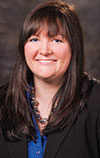Hot, dry summer months can create great hardships for management of beef heifers and cows. One way to help minimize stress on the land and resources available to you and your cowherd is to choose animals which have performance that is optimized for your production environment.
It is tempting to think about selection of herd sires and replacement heifers with the goal of maximizing production and the output from your herd. However, increased output has an associated cost and may not increase overall profitability. It only makes fiscal sense to continue to select for increased performance in a trait if the benefit outweighs the increased cost.
For example, continued selection for increased growth and milk without regard to the resources available for the cowherd can lead to increased mature size of cows and concurrent increased maintenance costs needed to maintain that larger body size and to sustain higher levels of lactation.
This can lead to overgrazing if stocking density is not decreased to account for the increased feed requirement, and an overall decrease in performance of cows and calves, loss of body condition and failure to rebreed if the maintenance requirements cannot be met with the available resources.
When nutrient resources are scarce, smaller, less-productive cows (those that are smaller-framed, have lower milk production and smaller calf-weaning weights) are more efficient at conversion of available resources. The smaller size of calves can be offset by a higher reproductive rate (due to their ability to maintain a reasonable body condition score), which nets more saleable product. When resources are abundant, larger, higher-performing and lactating cattle should be considered, as they should maximize profitability.
Selection for optimized performance is not a one-size-fits-all paradigm and these decisions should be made with consideration for each individual operation. Some breed associations and other organizations have decision support tools which help identify sires or EPD ranges that are optimal for your operation based on user-provided inputs. It should be noted that these tools usually have assumed specifications (such as the bulls are being used as a terminal sire and no replacements are kept) that users should be cognizant of when applying the output for selection within their herds.
Optimization of performance within your production system will not only increase profit but will help to maintain a sustainable beef operation and enhance stewardship of your land. When you choose cattle that are profitable in your environment, you will learn to appreciate the way they look! ![]()
—From Cow/Calf Corner e-newsletter from the Oklahoma Cooperative Extension Service, July 9, 2012









